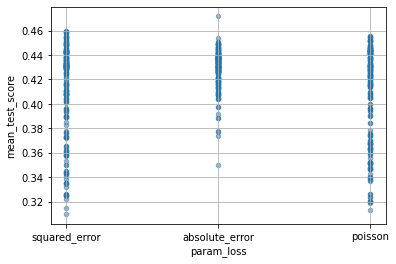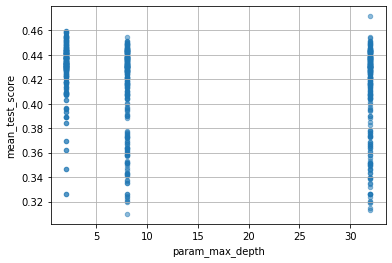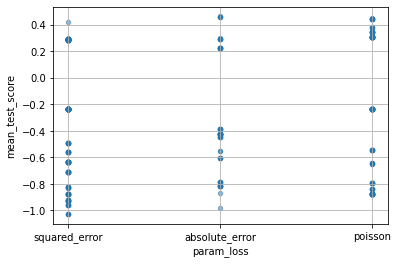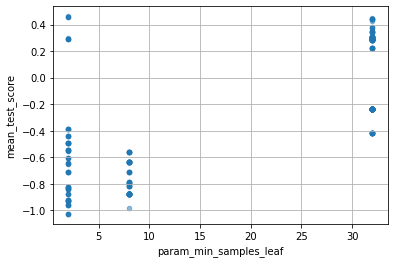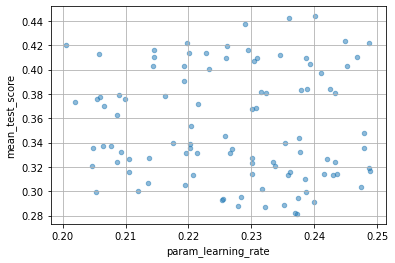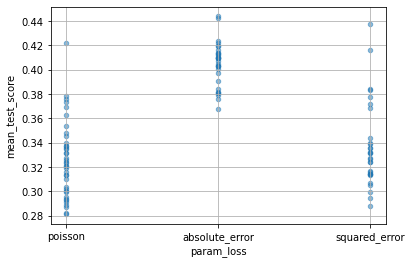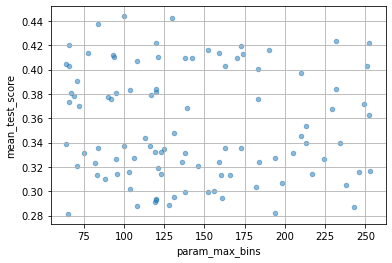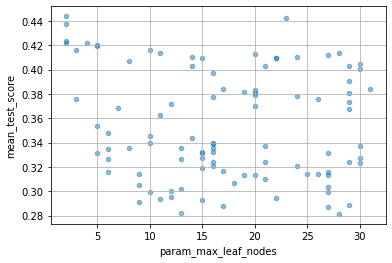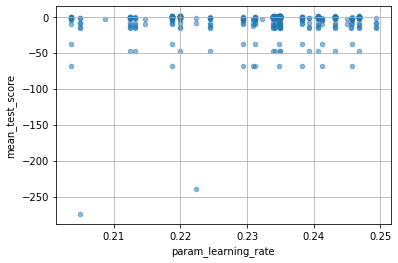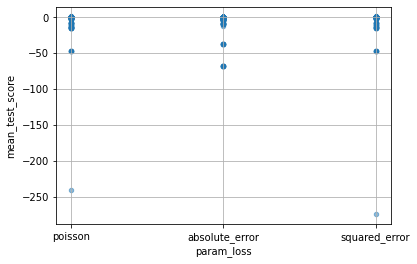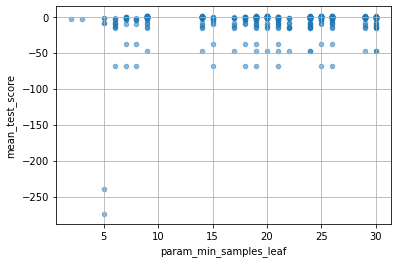機械学習でハイパーパラメーターチューニングといえば Optuna が柔軟なコーディングができて個人的にはお気に入りなんですが、scikit-learnのGridSearchCVとその兄弟たちの使い方を理解してみたくなったので試してみました。
データセットとその分割
回帰用データセットとして load_diabetes を用い、train_test_split を用いて教師データとテストデータに分割します。
import sklearn.datasets
from sklearn.model_selection import train_test_split
dataset = sklearn.datasets.load_diabetes()
X_train, X_test, Y_train, Y_test = train_test_split(dataset.data, dataset.target)
HistGradientBoostingRegressor
HistGradientBoostingRegressor は、非深層系機械学習モデルとして最強クラスと噂されている(?)勾配ブースティング回帰の、scikit-learnによる軽量型とのことです。
from sklearn.ensemble import HistGradientBoostingRegressor
model = HistGradientBoostingRegressor()
model.fit(X_train, Y_train)
model.score(X_test, Y_test)
0.3174338258206677
以上が、ハイパラチューニングなしでの結果となりますが、さてさて、GridSearchCV HalvingGridSearchCV RandomizedSearchCV HalvingRandomSearchCV の4つの CV (Cross Validation) 手法を用いてどのくらい改善できるでしょうか?
GridSearchCV
まずは GridSearchCV を使ってみましょう。GridSearchCV は、与えたパラメーターの全組み合わせに対して学習を行なって、ベストな学習器を発見します。
from sklearn.model_selection import GridSearchCV
parameters = dict(
{
"loss": ["squared_error", "absolute_error", "poisson"],
"learning_rate": [0.2, 0.1, 0.05],
"max_leaf_nodes": [2, 8, 32],
"max_depth": [2, 8, 32],
"min_samples_leaf": [2, 8, 32],
"max_bins": [64, 128, 255],
}
)
model = GridSearchCV(HistGradientBoostingRegressor(), parameters, cv=5, n_jobs=-1)
model.fit(X_train, Y_train)
print("R2=", model.score(X_test, Y_test))
model.best_estimator_
R2= 0.33232614171975594
少しは改善しましたね。そのベストモデルのハイパーパラメーターは次の通りです。
HistGradientBoostingRegressor(learning_rate=0.05, loss='absolute_error',
max_bins=128, max_depth=32, max_leaf_nodes=32,
min_samples_leaf=8)
以上のGridSearchCVの詳細な結果は次のように確認できます。
import pandas as pd
pd.DataFrame(model.cv_results_)
| mean_fit_time | std_fit_time | mean_score_time | std_score_time | param_learning_rate | param_loss | param_max_bins | param_max_depth | param_max_leaf_nodes | param_min_samples_leaf | params | split0_test_score | split1_test_score | split2_test_score | split3_test_score | split4_test_score | mean_test_score | std_test_score | rank_test_score | |
|---|---|---|---|---|---|---|---|---|---|---|---|---|---|---|---|---|---|---|---|
| 0 | 0.046092 | 0.001038 | 0.003924 | 0.000962 | 0.2 | squared_error | 64 | 2 | 2 | 2 | {'learning_rate': 0.2, 'loss': 'squared_error'... | 0.510208 | 0.403854 | 0.419810 | 0.316751 | 0.504165 | 0.430958 | 0.071473 | 344 |
| 1 | 0.047879 | 0.004027 | 0.003343 | 0.000078 | 0.2 | squared_error | 64 | 2 | 2 | 8 | {'learning_rate': 0.2, 'loss': 'squared_error'... | 0.534582 | 0.414399 | 0.412338 | 0.323632 | 0.506877 | 0.438365 | 0.075322 | 186 |
| 2 | 0.044900 | 0.001714 | 0.003401 | 0.000135 | 0.2 | squared_error | 64 | 2 | 2 | 32 | {'learning_rate': 0.2, 'loss': 'squared_error'... | 0.554374 | 0.445249 | 0.369375 | 0.315602 | 0.467517 | 0.430423 | 0.082305 | 357 |
| 3 | 0.080580 | 0.007363 | 0.004332 | 0.001743 | 0.2 | squared_error | 64 | 2 | 8 | 2 | {'learning_rate': 0.2, 'loss': 'squared_error'... | 0.425588 | 0.450360 | 0.362742 | 0.284584 | 0.443050 | 0.393265 | 0.062492 | 596 |
| 4 | 0.069854 | 0.004283 | 0.003402 | 0.000314 | 0.2 | squared_error | 64 | 2 | 8 | 8 | {'learning_rate': 0.2, 'loss': 'squared_error'... | 0.495745 | 0.401067 | 0.347681 | 0.262674 | 0.469976 | 0.395429 | 0.084328 | 590 |
| ... | ... | ... | ... | ... | ... | ... | ... | ... | ... | ... | ... | ... | ... | ... | ... | ... | ... | ... | ... |
| 724 | 0.145537 | 0.009800 | 0.003565 | 0.000112 | 0.05 | poisson | 255 | 32 | 8 | 8 | {'learning_rate': 0.05, 'loss': 'poisson', 'ma... | 0.536389 | 0.477789 | 0.396651 | 0.323495 | 0.397866 | 0.426438 | 0.073521 | 427 |
| 725 | 0.102996 | 0.001280 | 0.003632 | 0.000067 | 0.05 | poisson | 255 | 32 | 8 | 32 | {'learning_rate': 0.05, 'loss': 'poisson', 'ma... | 0.593431 | 0.462807 | 0.358350 | 0.390233 | 0.410602 | 0.443085 | 0.082488 | 120 |
| 726 | 0.565122 | 0.031652 | 0.005548 | 0.002976 | 0.05 | poisson | 255 | 32 | 32 | 2 | {'learning_rate': 0.05, 'loss': 'poisson', 'ma... | 0.474264 | 0.399449 | 0.398237 | 0.223435 | 0.258033 | 0.350683 | 0.094539 | 679 |
| 727 | 0.378403 | 0.015974 | 0.004088 | 0.000225 | 0.05 | poisson | 255 | 32 | 32 | 8 | {'learning_rate': 0.05, 'loss': 'poisson', 'ma... | 0.486323 | 0.485514 | 0.333050 | 0.337733 | 0.327221 | 0.393968 | 0.075152 | 595 |
| 728 | 0.099264 | 0.013943 | 0.003375 | 0.000581 | 0.05 | poisson | 255 | 32 | 32 | 32 | {'learning_rate': 0.05, 'loss': 'poisson', 'ma... | 0.593431 | 0.462807 | 0.358350 | 0.390233 | 0.410602 | 0.443085 | 0.082488 | 120 |
729 rows × 19 columns
今回、6種類のハイパーパラメータがそれぞれ3個の値を持っていたので 3 * 3 * 3 * 3 * 3 * 3 = 729 ということで、累計 729 個の機械学習モデルを生成したということで計算は合っていますね。
どのようなハイパラを探索していたか確認してみましょう。
pd.DataFrame(model.cv_results_["params"])
| learning_rate | loss | max_bins | max_depth | max_leaf_nodes | min_samples_leaf | |
|---|---|---|---|---|---|---|
| 0 | 0.20 | squared_error | 64 | 2 | 2 | 2 |
| 1 | 0.20 | squared_error | 64 | 2 | 2 | 8 |
| 2 | 0.20 | squared_error | 64 | 2 | 2 | 32 |
| 3 | 0.20 | squared_error | 64 | 2 | 8 | 2 |
| 4 | 0.20 | squared_error | 64 | 2 | 8 | 8 |
| ... | ... | ... | ... | ... | ... | ... |
| 724 | 0.05 | poisson | 255 | 32 | 8 | 8 |
| 725 | 0.05 | poisson | 255 | 32 | 8 | 32 |
| 726 | 0.05 | poisson | 255 | 32 | 32 | 2 |
| 727 | 0.05 | poisson | 255 | 32 | 32 | 8 |
| 728 | 0.05 | poisson | 255 | 32 | 32 | 32 |
729 rows × 6 columns
次のように結合してみます。
cv_results_df = pd.concat(
[pd.DataFrame(model.cv_results_), pd.DataFrame(model.cv_results_["params"])], axis=1
)
cv_results_df
| mean_fit_time | std_fit_time | mean_score_time | std_score_time | param_learning_rate | param_loss | param_max_bins | param_max_depth | param_max_leaf_nodes | param_min_samples_leaf | ... | split4_test_score | mean_test_score | std_test_score | rank_test_score | learning_rate | loss | max_bins | max_depth | max_leaf_nodes | min_samples_leaf | |
|---|---|---|---|---|---|---|---|---|---|---|---|---|---|---|---|---|---|---|---|---|---|
| 0 | 0.046092 | 0.001038 | 0.003924 | 0.000962 | 0.2 | squared_error | 64 | 2 | 2 | 2 | ... | 0.504165 | 0.430958 | 0.071473 | 344 | 0.20 | squared_error | 64 | 2 | 2 | 2 |
| 1 | 0.047879 | 0.004027 | 0.003343 | 0.000078 | 0.2 | squared_error | 64 | 2 | 2 | 8 | ... | 0.506877 | 0.438365 | 0.075322 | 186 | 0.20 | squared_error | 64 | 2 | 2 | 8 |
| 2 | 0.044900 | 0.001714 | 0.003401 | 0.000135 | 0.2 | squared_error | 64 | 2 | 2 | 32 | ... | 0.467517 | 0.430423 | 0.082305 | 357 | 0.20 | squared_error | 64 | 2 | 2 | 32 |
| 3 | 0.080580 | 0.007363 | 0.004332 | 0.001743 | 0.2 | squared_error | 64 | 2 | 8 | 2 | ... | 0.443050 | 0.393265 | 0.062492 | 596 | 0.20 | squared_error | 64 | 2 | 8 | 2 |
| 4 | 0.069854 | 0.004283 | 0.003402 | 0.000314 | 0.2 | squared_error | 64 | 2 | 8 | 8 | ... | 0.469976 | 0.395429 | 0.084328 | 590 | 0.20 | squared_error | 64 | 2 | 8 | 8 |
| ... | ... | ... | ... | ... | ... | ... | ... | ... | ... | ... | ... | ... | ... | ... | ... | ... | ... | ... | ... | ... | ... |
| 724 | 0.145537 | 0.009800 | 0.003565 | 0.000112 | 0.05 | poisson | 255 | 32 | 8 | 8 | ... | 0.397866 | 0.426438 | 0.073521 | 427 | 0.05 | poisson | 255 | 32 | 8 | 8 |
| 725 | 0.102996 | 0.001280 | 0.003632 | 0.000067 | 0.05 | poisson | 255 | 32 | 8 | 32 | ... | 0.410602 | 0.443085 | 0.082488 | 120 | 0.05 | poisson | 255 | 32 | 8 | 32 |
| 726 | 0.565122 | 0.031652 | 0.005548 | 0.002976 | 0.05 | poisson | 255 | 32 | 32 | 2 | ... | 0.258033 | 0.350683 | 0.094539 | 679 | 0.05 | poisson | 255 | 32 | 32 | 2 |
| 727 | 0.378403 | 0.015974 | 0.004088 | 0.000225 | 0.05 | poisson | 255 | 32 | 32 | 8 | ... | 0.327221 | 0.393968 | 0.075152 | 595 | 0.05 | poisson | 255 | 32 | 32 | 8 |
| 728 | 0.099264 | 0.013943 | 0.003375 | 0.000581 | 0.05 | poisson | 255 | 32 | 32 | 32 | ... | 0.410602 | 0.443085 | 0.082488 | 120 | 0.05 | poisson | 255 | 32 | 32 | 32 |
729 rows × 25 columns
次のようにすれば、各パラメーターが性能にどのくらい影響したかを確認できます。ただし、ここでいう mean_test_score は、ややこしいのですが、(X_test, Y_test) に対するscoreではなくて、(X_train, Y_train) を cv=5 として分割したときの test_score の平均ということになります。
for col in cv_results_df.columns:
if col[:6] == "param_":
cv_results_df.plot(col, "mean_test_score", kind="scatter", alpha=0.5, grid=True)
HalvingGridSearchCV
次は HalvingGridSearchCV です。これは、GridSearchCV と同様に全組み合わせを探索した後に、スコアの高かった組み合わせを取り出し、上位のモデルに対してより多い resource を与えて再学習を行うという操作を繰り返します。
上位いくつの組み合わせを選ぶかは factor というパラメーターで調整できます(たとえば factor=2 とすれば上位 1/2 のモデルが選択されます)。
resource とは何か、というのは base となる estimator によって変わるらしく、GradientBoosting のようなアンサンブル学習器なら n_estimators になるようです。
from sklearn.experimental import enable_halving_search_cv
from sklearn.model_selection import HalvingGridSearchCV
parameters = dict(
{
"loss": ["squared_error", "absolute_error", "poisson"],
"learning_rate": [0.2, 0.1, 0.05],
"max_leaf_nodes": [2, 8, 32],
"max_depth": [2, 8, 32],
"min_samples_leaf": [2, 8, 32],
"max_bins": [64, 128, 255],
}
)
model = HalvingGridSearchCV(
HistGradientBoostingRegressor(), parameters, cv=5, n_jobs=-1
)
model.fit(X_train, Y_train)
print("R2=", model.score(X_test, Y_test))
model.best_estimator_
R2= 0.45168983833467624
お、けっこう性能が向上しましたね。
HistGradientBoostingRegressor(learning_rate=0.2, loss='absolute_error',
max_bins=64, max_depth=2, max_leaf_nodes=2,
min_samples_leaf=2)
クロスバリデーションの詳細は次の通りです。 iter=0 では単純な GridSearchCV と同じ 3 * 3 * 3 * 3 * 3 * 3 = 729 個のモデルが学習され、上位 1/factor 個のモデルが選択され、より多い resource で再学習されるということを繰り返します。
cv_results_df = pd.concat(
[pd.DataFrame(model.cv_results_), pd.DataFrame(model.cv_results_["params"])], axis=1
)
cv_results_df
| iter | n_resources | mean_fit_time | std_fit_time | mean_score_time | std_score_time | param_learning_rate | param_loss | param_max_bins | param_max_depth | ... | split3_train_score | split4_train_score | mean_train_score | std_train_score | learning_rate | loss | max_bins | max_depth | max_leaf_nodes | min_samples_leaf | |
|---|---|---|---|---|---|---|---|---|---|---|---|---|---|---|---|---|---|---|---|---|---|
| 0 | 0 | 10 | 0.073146 | 0.035112 | 0.008809 | 0.005226 | 0.2 | squared_error | 64 | 2 | ... | 0.999956 | 0.999969 | 0.999855 | 2.293240e-04 | 0.20 | squared_error | 64 | 2 | 2 | 2 |
| 1 | 0 | 10 | 0.036513 | 0.015857 | 0.007700 | 0.005450 | 0.2 | squared_error | 64 | 2 | ... | 0.000000 | 0.000000 | 0.000000 | 0.000000e+00 | 0.20 | squared_error | 64 | 2 | 2 | 8 |
| 2 | 0 | 10 | 0.048790 | 0.014432 | 0.005903 | 0.003738 | 0.2 | squared_error | 64 | 2 | ... | 0.000000 | 0.000000 | 0.000000 | 0.000000e+00 | 0.20 | squared_error | 64 | 2 | 2 | 32 |
| 3 | 0 | 10 | 0.117461 | 0.019852 | 0.007106 | 0.005961 | 0.2 | squared_error | 64 | 2 | ... | 1.000000 | 1.000000 | 1.000000 | 2.120790e-08 | 0.20 | squared_error | 64 | 2 | 8 | 2 |
| 4 | 0 | 10 | 0.052612 | 0.004677 | 0.004469 | 0.002280 | 0.2 | squared_error | 64 | 2 | ... | 0.000000 | 0.000000 | 0.000000 | 0.000000e+00 | 0.20 | squared_error | 64 | 2 | 8 | 8 |
| ... | ... | ... | ... | ... | ... | ... | ... | ... | ... | ... | ... | ... | ... | ... | ... | ... | ... | ... | ... | ... | ... |
| 1075 | 3 | 270 | 0.093966 | 0.012485 | 0.007732 | 0.006771 | 0.2 | poisson | 128 | 8 | ... | 0.633315 | 0.616487 | 0.614829 | 3.458072e-02 | 0.20 | poisson | 128 | 8 | 2 | 32 |
| 1076 | 3 | 270 | 0.136020 | 0.012811 | 0.003038 | 0.000059 | 0.2 | poisson | 128 | 2 | ... | 0.793938 | 0.759121 | 0.779202 | 2.804673e-02 | 0.20 | poisson | 128 | 2 | 32 | 32 |
| 1077 | 3 | 270 | 0.145647 | 0.047377 | 0.005804 | 0.003204 | 0.2 | poisson | 128 | 2 | ... | 0.793938 | 0.759121 | 0.779202 | 2.804673e-02 | 0.20 | poisson | 128 | 2 | 8 | 32 |
| 1078 | 3 | 270 | 0.129800 | 0.026974 | 0.003437 | 0.000220 | 0.2 | poisson | 64 | 32 | ... | 0.876194 | 0.870592 | 0.870216 | 1.899521e-02 | 0.20 | poisson | 64 | 32 | 32 | 32 |
| 1079 | 3 | 270 | 0.129445 | 0.042735 | 0.004040 | 0.001468 | 0.05 | poisson | 255 | 32 | ... | 0.723216 | 0.705591 | 0.705248 | 3.103351e-02 | 0.05 | poisson | 255 | 32 | 32 | 32 |
1080 rows × 34 columns
各パラメータが性能にどのような影響を与えたかは次のようにして見られます。
for col in cv_results_df.columns:
if col[:6] == "param_":
cv_results_df.plot(col, "mean_test_score", kind="scatter", alpha=0.5, grid=True)
より多い resource で再学習する分、性能が向上するというのは良いとしても、ハイパラの探索範囲は GridSearchCV と変わらないということですね。
RandomizedSearchCV
次は RandomizedSearchCV です。これは、名前から想像できる通り、指定したハイパーパラメーターの範囲をランダムにサーチします。反復回数は n_iter=100 のように指定します。
from scipy.stats import randint, uniform
from sklearn.model_selection import RandomizedSearchCV
parameters = dict(
{
"loss": ["squared_error", "absolute_error", "poisson"],
"learning_rate": uniform(0.2, 0.05),
"max_leaf_nodes": randint(2, 32),
"max_depth": randint(2, 32),
"min_samples_leaf": randint(2, 32),
"max_bins": randint(64, 255),
}
)
model = RandomizedSearchCV(
HistGradientBoostingRegressor(), parameters, cv=5, n_jobs=-1, n_iter=100
)
model.fit(X_train, Y_train)
print("R2=", model.score(X_test, Y_test))
model.best_estimator_
R2= 0.44293642952519996
今回、GridSearchCVよりは改善しましたが、HalvingGridSearchCVには負けた、という形ですね。
HistGradientBoostingRegressor(learning_rate=0.2401623294668279,
loss='absolute_error', max_bins=100, max_depth=27,
max_leaf_nodes=2, min_samples_leaf=31)
結果の詳細です。
cv_results_df = pd.concat(
[pd.DataFrame(model.cv_results_), pd.DataFrame(model.cv_results_["params"])], axis=1
)
cv_results_df
| mean_fit_time | std_fit_time | mean_score_time | std_score_time | param_learning_rate | param_loss | param_max_bins | param_max_depth | param_max_leaf_nodes | param_min_samples_leaf | ... | split4_test_score | mean_test_score | std_test_score | rank_test_score | learning_rate | loss | max_bins | max_depth | max_leaf_nodes | min_samples_leaf | |
|---|---|---|---|---|---|---|---|---|---|---|---|---|---|---|---|---|---|---|---|---|---|
| 0 | 0.366715 | 0.053425 | 0.014998 | 0.003574 | 0.230097 | poisson | 82 | 3 | 30 | 9 | ... | 0.274491 | 0.323229 | 0.060283 | 70 | 0.230097 | poisson | 82 | 3 | 30 | 9 |
| 1 | 0.506211 | 0.144560 | 0.011002 | 0.006287 | 0.226155 | absolute_error | 173 | 27 | 5 | 10 | ... | 0.428027 | 0.419660 | 0.093885 | 8 | 0.226155 | absolute_error | 173 | 27 | 5 | 10 |
| 2 | 0.221872 | 0.035509 | 0.012181 | 0.007027 | 0.200513 | absolute_error | 66 | 23 | 5 | 30 | ... | 0.410435 | 0.419785 | 0.091442 | 7 | 0.200513 | absolute_error | 66 | 23 | 5 | 30 |
| 3 | 0.196586 | 0.026616 | 0.006464 | 0.003607 | 0.213685 | squared_error | 106 | 31 | 30 | 29 | ... | 0.322769 | 0.327327 | 0.089463 | 64 | 0.213685 | squared_error | 106 | 31 | 30 | 29 |
| 4 | 0.192499 | 0.050251 | 0.007767 | 0.003510 | 0.227877 | squared_error | 108 | 5 | 17 | 19 | ... | 0.254810 | 0.287950 | 0.057030 | 97 | 0.227877 | squared_error | 108 | 5 | 17 | 19 |
| ... | ... | ... | ... | ... | ... | ... | ... | ... | ... | ... | ... | ... | ... | ... | ... | ... | ... | ... | ... | ... | ... |
| 95 | 0.399913 | 0.010536 | 0.003984 | 0.000305 | 0.22602 | absolute_error | 170 | 26 | 15 | 5 | ... | 0.436215 | 0.409727 | 0.062342 | 17 | 0.226020 | absolute_error | 170 | 26 | 15 | 5 |
| 96 | 0.083641 | 0.015314 | 0.003447 | 0.000209 | 0.206473 | poisson | 116 | 2 | 30 | 4 | ... | 0.376263 | 0.337107 | 0.027581 | 53 | 0.206473 | poisson | 116 | 2 | 30 | 4 |
| 97 | 0.163723 | 0.090995 | 0.009293 | 0.004980 | 0.23693 | poisson | 194 | 3 | 13 | 13 | ... | 0.285729 | 0.282265 | 0.052020 | 99 | 0.236930 | poisson | 194 | 3 | 13 | 13 |
| 98 | 0.551714 | 0.115441 | 0.004080 | 0.000183 | 0.233486 | squared_error | 159 | 16 | 29 | 2 | ... | 0.315230 | 0.323911 | 0.061675 | 68 | 0.233486 | squared_error | 159 | 16 | 29 | 2 |
| 99 | 0.181508 | 0.039065 | 0.003228 | 0.000828 | 0.221521 | squared_error | 249 | 18 | 12 | 6 | ... | 0.363508 | 0.371630 | 0.068751 | 40 | 0.221521 | squared_error | 249 | 18 | 12 | 6 |
100 rows × 25 columns
ランダムなので、最適なハイパラの値がほとんど見当がつかないような時に便利なんだろうと思います。
for col in cv_results_df.columns:
if col[:6] == "param_":
cv_results_df.plot(col, "mean_test_score", kind="scatter", alpha=0.5, grid=True)
HalvingRandomSearchCV
最後に、HalvingRandomSearchCVです。これは、GridSearchCVに対するHalvingGridSearchCVと同様に、RandomSearchCVに対して、上位いくつかのモデルに対してresouceを増やして再計算するというものです。
from scipy.stats import randint, uniform
from sklearn.experimental import enable_halving_search_cv
from sklearn.model_selection import HalvingRandomSearchCV
parameters = dict(
{
"loss": ["squared_error", "absolute_error", "poisson"],
"learning_rate": uniform(0.2, 0.05),
"max_leaf_nodes": randint(2, 32),
"max_depth": randint(2, 32),
"min_samples_leaf": randint(2, 32),
"max_bins": randint(64, 255),
}
)
model = HalvingRandomSearchCV(
HistGradientBoostingRegressor(), parameters, cv=5, n_jobs=-1, factor=1.1
)
model.fit(X_train, Y_train)
print("R2=", model.score(X_test, Y_test))
model.best_estimator_
R2= 0.36263251102607696
残念ながら、あまり良い成績は出ませんでしたね(私が上手に使いこなしていないだけかもしれませんが)。
HistGradientBoostingRegressor(learning_rate=0.23484210133032557,
loss='absolute_error', max_bins=176, max_depth=19,
max_leaf_nodes=16, min_samples_leaf=25)
詳細な結果は次のとおりです。
cv_results_df = pd.concat(
[pd.DataFrame(model.cv_results_), pd.DataFrame(model.cv_results_["params"])], axis=1
)
cv_results_df
| iter | n_resources | mean_fit_time | std_fit_time | mean_score_time | std_score_time | param_learning_rate | param_loss | param_max_bins | param_max_depth | ... | split3_train_score | split4_train_score | mean_train_score | std_train_score | learning_rate | loss | max_bins | max_depth | max_leaf_nodes | min_samples_leaf | |
|---|---|---|---|---|---|---|---|---|---|---|---|---|---|---|---|---|---|---|---|---|---|
| 0 | 0 | 10 | 0.025926 | 0.002128 | 0.003607 | 0.001518 | 0.213565 | poisson | 155 | 30 | ... | 0.000000 | 0.000000 | -4.440892e-17 | 8.881784e-17 | 0.213565 | poisson | 155 | 30 | 5 | 25 |
| 1 | 0 | 10 | 0.039488 | 0.001897 | 0.002757 | 0.000126 | 0.203592 | absolute_error | 238 | 14 | ... | -0.031997 | -0.014562 | -1.044763e-02 | 1.188607e-02 | 0.203592 | absolute_error | 238 | 14 | 11 | 7 |
| 2 | 0 | 10 | 0.027985 | 0.003291 | 0.003110 | 0.000359 | 0.234896 | poisson | 212 | 26 | ... | 0.000000 | 0.000000 | -4.440892e-17 | 8.881784e-17 | 0.234896 | poisson | 212 | 26 | 2 | 20 |
| 3 | 0 | 10 | 0.027623 | 0.006139 | 0.004061 | 0.002246 | 0.222381 | poisson | 213 | 25 | ... | 0.000000 | 0.000000 | -4.440892e-17 | 8.881784e-17 | 0.222381 | poisson | 213 | 25 | 18 | 5 |
| 4 | 0 | 10 | 0.025690 | 0.002067 | 0.002841 | 0.000024 | 0.245578 | poisson | 138 | 19 | ... | 0.000000 | 0.000000 | -4.440892e-17 | 8.881784e-17 | 0.245578 | poisson | 138 | 19 | 6 | 26 |
| ... | ... | ... | ... | ... | ... | ... | ... | ... | ... | ... | ... | ... | ... | ... | ... | ... | ... | ... | ... | ... | ... |
| 523 | 36 | 309 | 0.108649 | 0.005772 | 0.003502 | 0.000146 | 0.246763 | poisson | 135 | 20 | ... | 0.934394 | 0.927940 | 9.328288e-01 | 6.655434e-03 | 0.246763 | poisson | 135 | 20 | 15 | 30 |
| 524 | 36 | 309 | 0.252199 | 0.070923 | 0.005747 | 0.003214 | 0.234842 | absolute_error | 176 | 19 | ... | 0.802983 | 0.786075 | 7.970137e-01 | 8.098674e-03 | 0.234842 | absolute_error | 176 | 19 | 16 | 25 |
| 525 | 36 | 309 | 0.080884 | 0.028918 | 0.005850 | 0.002895 | 0.234896 | poisson | 212 | 26 | ... | 0.661155 | 0.632498 | 6.533541e-01 | 1.317376e-02 | 0.234896 | poisson | 212 | 26 | 2 | 20 |
| 526 | 36 | 309 | 0.090304 | 0.029305 | 0.007267 | 0.003304 | 0.219922 | poisson | 205 | 30 | ... | 0.662939 | 0.635429 | 6.565455e-01 | 1.248445e-02 | 0.219922 | poisson | 205 | 30 | 2 | 9 |
| 527 | 36 | 309 | 0.332935 | 0.057465 | 0.005539 | 0.003033 | 0.218705 | absolute_error | 142 | 11 | ... | 0.795818 | 0.769511 | 7.827088e-01 | 1.634937e-02 | 0.218705 | absolute_error | 142 | 11 | 16 | 26 |
528 rows × 34 columns
以下の図を見ればわかりますが、最初の iteration の RandomSearchCV で決めたパラメータを変更することなく resource だけ変更しているようです。ここんとこ、改善の余地がありそうな気がしますね。
for col in cv_results_df.columns:
if col[:6] == "param_":
cv_results_df.plot(col, "mean_test_score", kind="scatter", alpha=0.5, grid=True)
おわりに
というわけで、scikit-learn の GridSearchCV とその兄弟たち HalvingGridSearchCV RandomizedSearchCV HalvingRandomSearchCV を使ってみました。その挙動は色々と参考になりますが、個人的にはやっぱりOptunaが柔軟な使い方ができて良いかなと再認識しました。私が使いこなしてないだけかもしれませんが。

